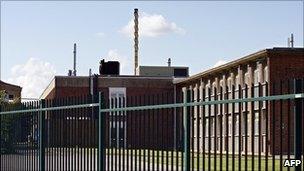'Safety incidents' at animal lab
- Published

The institute is located at Pirbright in Surrey
The Health and Safety Executive (HSE) has taken action against an animal health laboratory at the centre of a foot-and-mouth outbreak four years ago.
The agency has served the Institute for Animal Health (IAH) with two "improvement notices" following two incidents earlier this year involving infectious material.
The institute in Pirbright, Surrey, has appealed against one of the incidents.
Both were reported to the Health and Safety Executive by IAH managers.
The first incident occurred in January when a flask containing foot-and-mouth virus cracked and leaked. The flask was over a sink and infectious material went down a secure drainage system. It therefore did not leak into the environment.
The second incident occurred in February in an incinerator that was burning cow carcasses. Liquid leaked out of the incinerator, but not out of the incinerator building.
Inspectors from the HSE concluded that both were serious incidents and there had been a breach of health and safety legislation in each case.
Improvement notices were served on 25 March which outlined detailed measures the Institute had to take in order to rectify their equipment and procedures so that there would be no repeat of the accidents.
The institute has complied with the incident involving the incinerator but has appealed against the one involving the flask.
The Pirbright site was at the centre of an outbreak of foot-and-mouth disease in August 2007, which led to the slaughter of over 2,100 animals in Surrey and Berkshire.
At the time, official investigations indicated that the virus could have originated from the Pirbright site, where two separate organisations were based: the Institute for Animal Health and the private firm Merial Animal Health Ltd.
No prosecution was brought against either organisation after Surrey County Council said there was a lack of evidence to pinpoint the exact source of the outbreak, which cost the farming industry tens of millions of pounds.
Around 1,000 cattle, a similar number of pigs, as well as some sheep and goats on eight farms were slaughtered after livestock were infected with foot-and-mouth, probably due to live virus used in the development of a vaccine leaking from faulty pipework and spreading from the site.
A HSE spokesman said: "HSE can confirm that two improvement notices have been issued, one of which has been complied with and one of which has been appealed. While the appeal is being heard, HSE is not able to comment on the content of either of the notices."
In a joint statement, the IAH and the Biotechnology and Biological Sciences Research Council (BBSRC) said: "The nature of the world leading research carried out at IAH means that it is necessary for work to be conducted on dangerous viral pathogens.
"Since it is impossible to guarantee that pathogens will not occasionally escape from primary containment, for instance due to accidental breakages or spills in the laboratory, the facilities at IAH are operated within multiple layers of containment."
It said that the IAH had invested £30m in facility improvements and new infrastructure developments since 2007. The statement said that a further £100m was being invested in upgrading the site; these improvements are due to be complete in 2014.
- Published6 May 2011